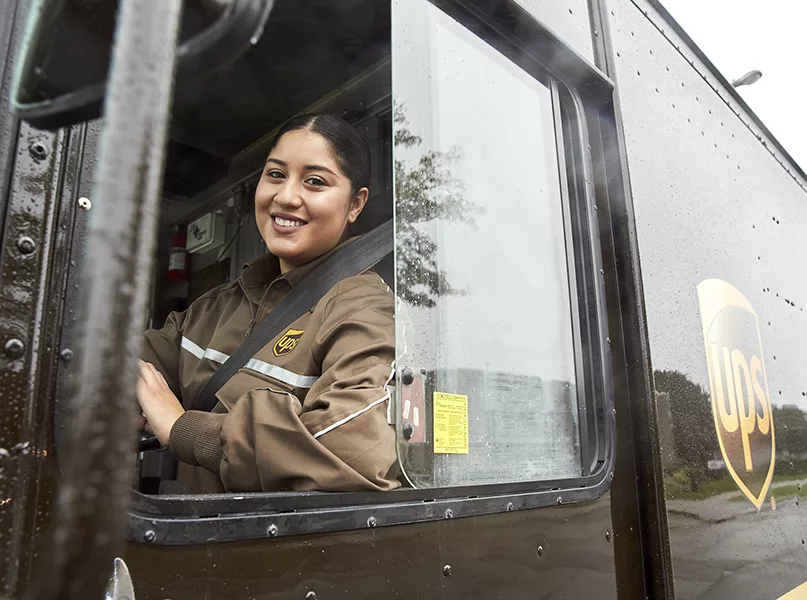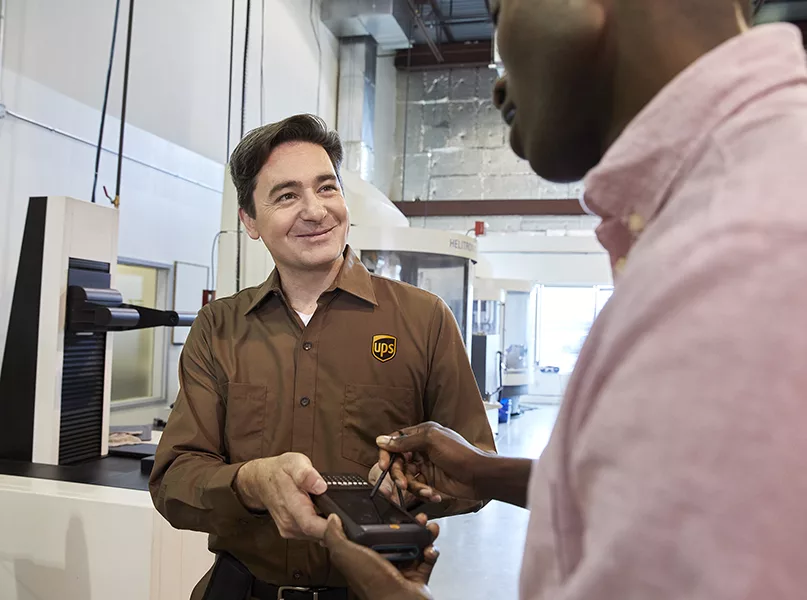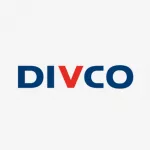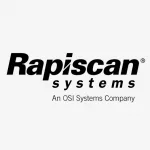INVESTING IN WOMEN-OWNED BUSINESSES
UPS and The UPS Foundation launched the Women Exporters Program (WEP) in 2018 to address the disparity between men and women regarding education and workforce participation. The program provides targeted assistance to female-owned SMBs worldwide.
Women-owned businesses account for almost one-fifth of all private sector businesses in Canada. However, they are still underrepresented in terms of export activity, which creates a huge opportunity for growth.
“We saw a need to help bridge the gender gap in education and export participation, so we’ve partnered with Startup Canada, an independent NPO, to expand and provide the tools and training to assist women-owned businesses grow globally,” Dexter highlights.
As of January 2023, WEP has trained over 107,000 female SMB owners all over the world.
“WEP provides tools, training, and networks to help women-owned SMBs connect with potential customers globally through international trade and e-commerce.”
As part of the program, women gain valuable knowledge about exporting, from market access to regulatory considerations. Furthermore, they receive advisory support from small business associations, UPS partners, and Startup Canada mentors and advisors, connect with UPS ambassadors, and are eligible for in-kind shipping credits and special shipping discounts from the company.
“So far, we have had 150 participants from across the country attending webinars addressing the ‘why’ and ‘how’ of exporting, including a walk through the process. We want to change the narrative that you must be a big business to export your products when you just need the correct tools,” she outlines.
UPS’s partnership with Startup Canada goes beyond WEP, as through the affiliation, it reaches over 100,000 entrepreneurs across the country.
The courier company works with Startup Canada on its Startup Women, Startup Canada Tour, and Startup Gov programs. Participants in WEP additionally have access to connect and engage with Startup Women and Startup Global leaders.
“We are focused on helping small businesses succeed and grow; therefore, our partnership with Startup Canada has been invaluable in enabling us to reach more SMBs,” expresses Dexter.
Startup Canada supports the various needs of SMBs, including connecting them with partners like UPS that have the resources and infrastructure to help them succeed.
“We love to help train, empower, and deliver services to SMBs that give them a competitive edge. Our superior standing in the US market, for example, enables SMBs to expand their footprint outside of Canada with the assurance of visibility tools and excellent service,” Dexter elaborates.

DELIVERING WHAT MATTERS
By October 2020, over 40 percent of Black-owned small businesses were forced to close due to the COVID-19 pandemic. In response, UPS launched a campaign in 2021 to celebrate the power and uniqueness of minority-owned SMBs.
UPS strongly believes in the vital role played by SMBs in shaping local communities and driving the global economy. In line with this belief, Proudly Unstoppable was incepted to showcase UPS’s unwavering support for SMBs. Through this initiative, UPS aims to demonstrate that it is not solely focused on serving large businesses, but actively seeks to empower and support SMBs.
The Proudly Unstoppable initiative reached Canada, China, and Germany to support diverse-owned businesses disproportionately affected by the COVID-19 pandemic. It was designed to empower women-owned SMBs around the world, helping them grow and thrive.
Specially designed, limited edition UPS Express Boxes feature the artwork of three female artists from each country the initiative reached. It was the first time UPS has displayed art on its boxes in over 118 years of business.
After shining a light on Black-owned SMBs, the Proudly Unstoppable campaign was expanded to support SMBs with LGBTQIA+, Latinx, and Asian American and Pacific Islander (AAPI) ownership.
The company ran a campaign aimed at supporting SMBs owned by minorities, showing them how they could succeed and thrive in their chosen market with the help of UPS’s expertise and their own passion. The campaign featured online videos encouraging SMB owners to be bold, be brave, and be unstoppable.
Financial exclusion presents a significant challenge for female entrepreneurs as they try to access capital to start, operate, or expand their businesses. Through efforts such as Proudly Unstoppable, UPS continues to help women obtain resources as the campaign strives to make a tangible impact.
The artists were offered essential information to effectively illustrate the power of women supporting and lifting each other up. For instance, Marian Bantjes, a Canadian artist, boldly portrayed a pattern of women holding hands, symbolizing the undeniably strong values of connectivity, unity, and community.
Meanwhile, Chen Peng, an artist from China, shows the vital role of Chinese women in society, with SMB owners from different professions helping and supporting each other, whilst German artist Dani Pollehn rendered the hero in a confident and charismatic manner, wearing a vibrant coat which embodies her success.
UPS is a driving force in promoting diversity and inclusivity and is committed to creating a world where everyone is valued and respected. By prioritizing these values, UPS is not only positively impacting its employees and customers but also setting an example for other companies to follow. There is no doubt that UPS is moving the world forward towards a brighter and more equitable future.
THE FUTURE IS BRIGHT
UPS Canada looks to improve its customer value proposition each year, increasing talent development and employee engagement and leveraging its physical network with a digital platform to drive logistics as a service.
“We are focused on driving growth and creating value for our customers across the Canadian network to stay ahead of the ever-changing logistics landscape. We will achieve this through new digital products and expanded service offerings, including Saturday delivery, adding capacity to our network, increasing efficiencies through automation, and growing our volume of packages to create more jobs,” Dexter reveals.
Currently, it is an exciting time for UPS Canada as the company is working on several ongoing and upcoming projects to improve its customer service and enhance its operational efficiency across the country.
Guided by its values and driven by innovative strategies, the future of UPS Canada is as promising as ever.
“We will continue to lean into the parts of the market that value UPS’s integrated end-to-end network, focusing on speed, service, and customer experience. These are areas that do and will continue to differentiate UPS Canada and the wider organization from the competition,” concludes Dexter.
With nearly 50 years of delivering quality service in Canada, the company has much to look forward to in the future, with sustainability initiatives, women in business programs, and the implementation of its new Saturday residential deliveries with its UPS Standard service.
UPS Canada is strategy-driven and people-led, and as customers want a trustworthy and reliable courier service, the company will continue to innovate and uphold its standards.

A BRIEF HISTORY OF UPS
UPS Founder, Jim Casey, left school at age 11 in 1899 due to his family’s financial struggles and began working as a delivery boy in Seattle. He worked for a department store before moving on to a tea store. After two years, he decided to work as an American District Telegraph (A.D.T.) messenger boy while returning to school. With his younger brothers also working, they were able to support their family after their father fell ill and died. Their mother managed the household alone with prudence and frugality, providing them with clean clothes and warm meals despite their varying schedules. Inspired by his mother’s ethics and encouragement, Casey returned to seventh grade with ambitions of attending Yale or Harvard like President Theodore Roosevelt; however, he only made it halfway through high school while still working long hours at A.D.T., including night shifts during summer vacation.
During his time at A.D.T., Casey worked under Frank Edwards, who later became Mayor of Seattle. His first job was to carry a heavy bag for a lady to a suburban car terminal. As an A.D.T. messenger boy, Casey had many experiences dealing with different people and circumstances. His tasks varied greatly: delivering telegrams; waking up engineers and firemen in the middle of the night for emergency railroad runs; carrying trays of food from restaurants to hotels; delivering written messages before the extensive use of telephones; collecting mail from post offices; running errands for retail stores; fetching bail money for prisoners in jail; transporting pitchers of beer from saloons to homes (“rushing the growler”); and even babysitting in hotel rooms while parents attended theater shows.
During the gold rush era, Seattle was the main port for Alaska-bound miners who spent winters there due to harsh mining conditions. These miners often carried bags of gold dust and nuggets which they spent freely while waiting for spring. As Jim walked through rainy streets on his errands, he envied these men sitting comfortably in hotel lobbies dreaming that one day he could do the same.
Casey, along with two fellow messengers, left A.D.T. and started their own messenger business. They relied on telephones for communication as they were becoming more common at that time. After nearly two years in this business, they sold it to seek fortunes in Nevada’s gold fields. In Goldfield, Nevada, instead of finding gold, they established a messenger service where they did all the work themselves. This venture lasted over a year despite interruptions and changes in partnership. After leaving Goldfield without any fortune, Casey returned to Seattle where he was invited to establish another messenger service due to his experience. At 19 years old, he had to start anew.
In August 1907, Casey and his partners started the American Messenger Company in Seattle. They rented a small space under a sidewalk next to a saloon for $25 per month (later reduced to $15) and equipped it with an old counter, two telephones, and a bench for their five or six messenger boys. The company advertised as offering the “Best Service – Lowest Rates”, which was challenging given the competition. They carefully selected reliable boys who lived at home with their parents and provided them with uniform caps. Instead of promising immediate service when they couldn’t deliver, they gave honest estimates of delivery times. Despite few calls initially, they stayed open all night and on Sundays to ensure reliability. The rate for short trips was 15 cents, but they established zone rates up to 65 cents for distant trips. Large customers were offered monthly discounts based on volume. To reduce costs further and attract more business from retail stores, they began consolidating deliveries on regular schedules in 1913 using one Ford car and several motorcycles. Their corporate name changed to Merchants Parcel Delivery, reflecting this shift in focus, and later became United Parcel Service. After realizing that there were only a few successful parcel delivery businesses across the US, Casey concluded that success would require innovative ideas beyond what others had done before.
Preceding the creation of UPS is the rich history of the courier industry, which dates back all the way to ancient Egypt when letters would be sent in a box down the River Nile, escorted by a guard.
The world’s first sophisticated postal service can be traced back to 521 BCE when Cyrus the Great is believed to have set up roads to transport general mail between his citizens and neighboring cities.
The word ‘courier’ originates from the Latin ‘currere’, which means ‘to run’, and marathon refers to the Greek messenger Pheidippides, who ran 26 miles to Athens after the Battle of Marathon to announce their defeat of the Persians. After promptly dying on arrival, he was memorialized in marathon events we see today.
Horses eventually replaced couriers on foot, with Greeks and Romans making deliveries by horse and chariot the most common method.
Nevertheless, being a courier is one of the oldest professions in the world. It became a vocation in the Middle Ages and evolved as royal courts began to pay messengers to deliver letters.
Today, communication via mail is disappearing, with modern technology connecting people globally, quickly, and efficiently.
Still, being a courier wasn’t for the faint-hearted. During the US Civil War and the Louisiana Purchase, the California Gold Rush brought 300,000 people from throughout the country and overseas to the Sierra Nevada mountain range.
At this time, The Pony Express was incepted, shipping packages from the East to the West Coast in just 10 days by horseback rather than stagecoach, transforming the courier industry.
Although the service was credited for its speed and efficiency, technological advancement soon replaced it.
Before the mid-1800s, there weren’t any actual courier companies with a broader network in the US. The first nationwide and international delivery business established in the country was Wells Fargo in 1852, who transported payments and valuables by steamboat and stagecoach, which, by today’s standards, weren’t very timely or reliable.
In 1918, the first shipment was transported by air from the US at a time when packages were mostly sent via train, truck, or motorcycle. In the same year, the first official airmail flight was made in Canada from Montréal to Toronto.
Leading the way, Winnipeg installed equipment that automatically segregates, stacks, and cancels mail – the first of its kind in North America.
Meanwhile, in the UK, between 1927 and 2003, the London Underground was used as a courier service called ‘Mail Rail’. Although it had a long run, it was eventually phased out as it became much more expensive than modern courier services. No matter how mail and packages are delivered, couriers hold a special place in US history. Spanning from 1775, when Paul Revere, known for his Midnight Ride, rode through the towns of Lexington and Concorde on horseback to warn residents of the approach of the British militia, to the current integrated technology that is key to a modern-day, efficient delivery system.
UPS CANADA PARTNERS






































